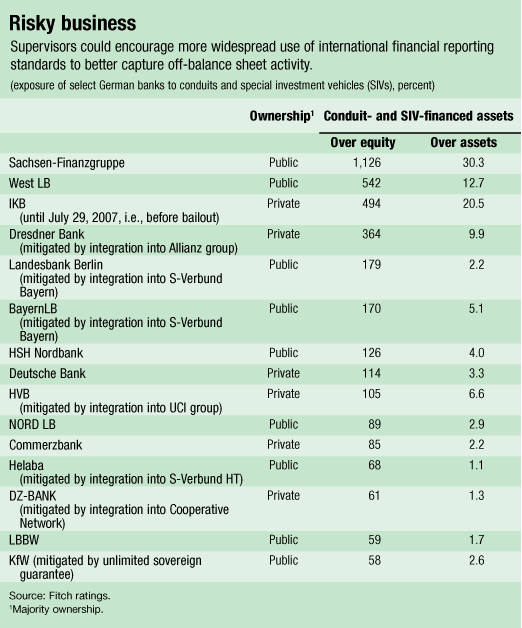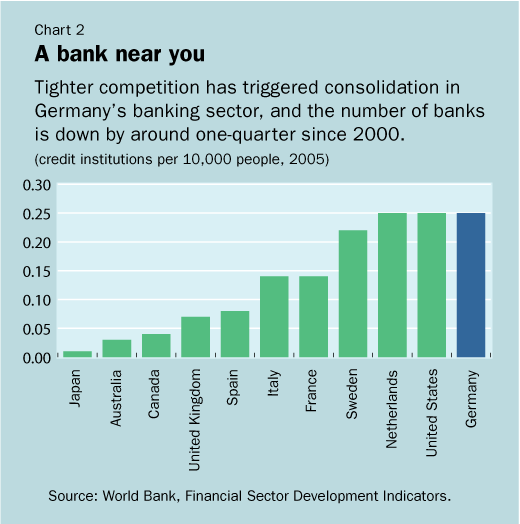ANNUAL ECONOMIC HEALTH CHECK

Typical street scene in Santa Ana, El Salvador. (Photo: iStock)
IMF Survey: Germany: Policy Lessons from Financial Market Turbulence
April 23, 2008
- Bank rescues underscore structural challenges faced by banking sector
- Private capital has legitimate role in coming public sector bank consolidation
- Further progress needed to strengthen supervision, enhance crisis prevention
Reverberations from the U.S. subprime mortgage crisis that first hit Germany in mid-2007 have started to change the country's financial sector.

Duesseldorf headquarters of Germany's IKB bank, whose near-collapse heralded arrival in Europe of U.S. subprime crisis (photo: Volker Hartmann/AFP/Getty)
The near-collapse last July of IKB, the first mid-size German bank in three decades to face serious problems, indicates low profitability and excessive risk taking among some German banks.
A swift but costly rescue
Although there was a confluence of factors at work, two factors in particular precipitated the latest financial market crisis and pertain to banks' so called conduits or special investment vehicles (SIVs). Banks would sponsor these vehicles to maintain investments off-balance sheet, typically in an attempt to minimize costly capital requirements (see table).
First, these investment vehicles tended to invest in longer-dated securities, such as subprime mortgages, and financed these investments by issuing short-dated commercial paper.
Second, as an increase in default rates on subprime mortgages raised doubts about the asset quality of their investments, the investment vehicles encountered serious difficulties in rolling over their short-term financing.
The resulting financing squeeze triggered a contractual obligation on the part of IKB and other banks to provide financing to the investment vehicles they sponsored. However, once it became apparent that IKB was unable to honor its commitment, a swift rescue was put in place to limit any further fallout. As the crisis deepened, further write-offs necessitated additional support and, by March 2008, the estimated rescue costs mounted to almost €8 billion, exceeding the bank's equity about fivefold.
IKB's problems heralded the arrival in Europe of the financial crisis that was unleashed in the U.S. subprime market. While the IMF's most recent annual assessment of Germany's economy covered a broad range of issues, the lessons from the ongoing financial market turbulence were specifically highlighted.
The ensuing rescue of IKB, a private bank, was shouldered in large part by the KFW, a public sector bank that owned 38 percent of IKB at the onset of the crisis. Sachsen LB, a public sector bank, faced similar difficulties in August 2007 and was rescued by Germany's largest public sector bank.
Large writedowns
West LB, another prominent public sector bank, also faced severe difficulties that necessitated a rescue package in early 2008. In addition many other private and public banks reported larger than expected writedowns, including Bayern LB and Deutsche Bank more recently.
What do these events have in common? First and foremost, all three rescue efforts were swift but appreciably burdensome to the public purse. Notably, the KFW is widely expected to more than double its shareholdings of IKB as a result of the latest recapitalization, although efforts to divest its stake are already under way.

Structural Challenges
As a result of deep-rooted fragmentation, interest margins remain low by international standards, and Germany's banking sector has made only modest progress in generating income from nontraditional services (see Chart 1). Sector-wide profitability remains low and banks, therefore, may be inclined to take on excessive risks.

A case in point is the combination of high leverage ratios and the large scale of the conduits that were operated by the rescued institutions. More broadly, the recent turbulence has raised questions as to whether many banks—especially the Landesbanken—have viable business models. The latest report maps out policy options for effective banking sector restructuring, enhanced supervision, and successful crisis prevention and management.
Banking sector restructuring
Amid heightening competitive pressures, banking sector consolidation is proceeding, with the number of banks having declined by approximately one quarter since the beginning of this decade (see Chart 2). Although public sector banks have been critical to this progress, the process of public mergers has often been ad hoc.

Moreover, the current policy of consolidating mainly from within the public pillar of the three-pillar banking system—comprising the private, cooperative, and public pillars—risks creating regional banks that may not withstand intensifying global financial sector competition.
To ensure that viability of business models is achieved, policy measures must ensure that market forces and private sector capital can play their legitimate role. Broadening private sector investment opportunities in the public pillar—as was the case of HSH Nordbank in 2006—would be major step forward.
Lifting of regional limitations on the business operations of the publicly owned savings banks is needed to enhance the efficiency of the public pillar. Where political compromises are made, these should not be at the cost of constraining future options.
Strengthening supervision
Failures in U.S. mortgage origination and an internationally accepted ratings methodology also played a major role in the developments that led to the rescue of the above-mentioned banks. While their operations were, at least in broad terms, known to the supervisory authorities, the risks posed by their conduits were underestimated, not unlike in other countries.
In the current arrangement, supervision relies on both the Bundesbank and BaFin, the Federal Financial Supervisory Authority. Some progress has been made in reducing duplication of supervisory visits by both institutions as a result of a recently revised protocol governing coordination across these institutions.
However, more could be done and consolidation of bank supervision and prudential enforcement in either one of these institutions would increase accountability. Regulation will need to stay with BaFin to maintain its role as a consolidated supervisory agency and, under any supervisory arrangement, the Bundesbank would need all necessary information to fulfill its financial stability and lender-of-last-resort responsibilities.
Support crisis prevention
Effective implementation of the Basel II minimum capital adequacy standards will require reduced reliance on external auditors and stepped-up efforts to attract and retain skilled supervisors.
Greater transparency and stronger incentives for prudent action will support crisis prevention and management. The bank resolution framework should allow for quick resolution but improve management incentives by allowing for dilution of private shareholders' equity. Supervisors should require more frequent financial statements and encourage more widespread use of International Financial Reporting Standards to better capture off-balance-sheet activity.
Comments on this article should be sent to imfsurvey@imf.org







